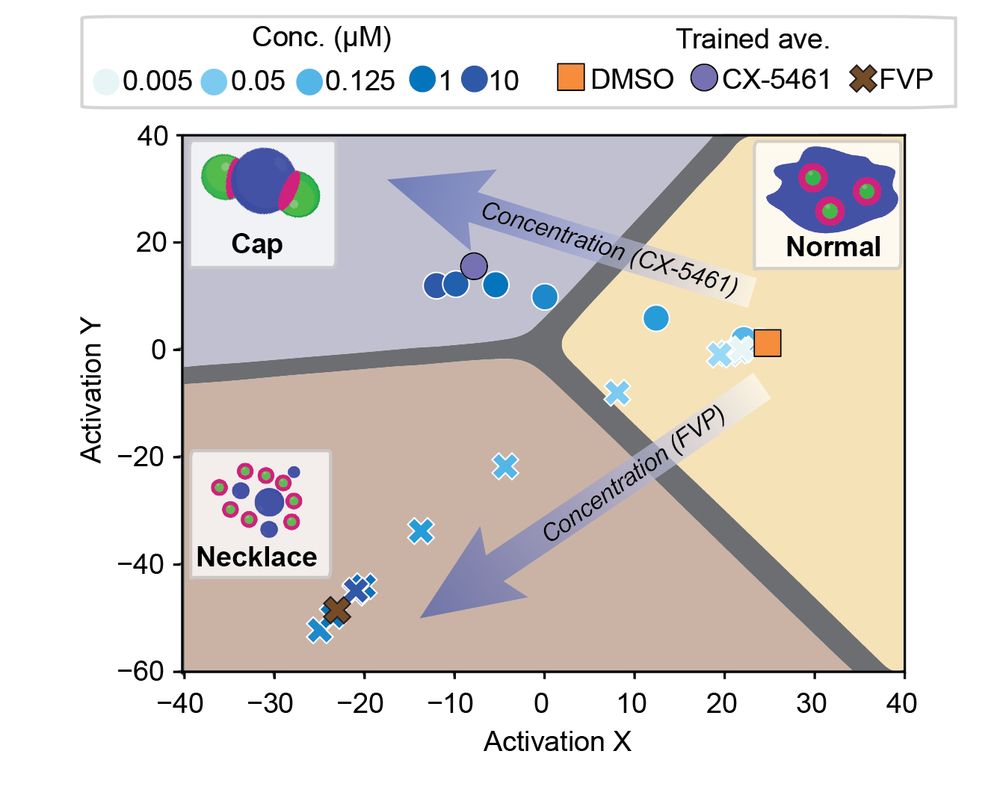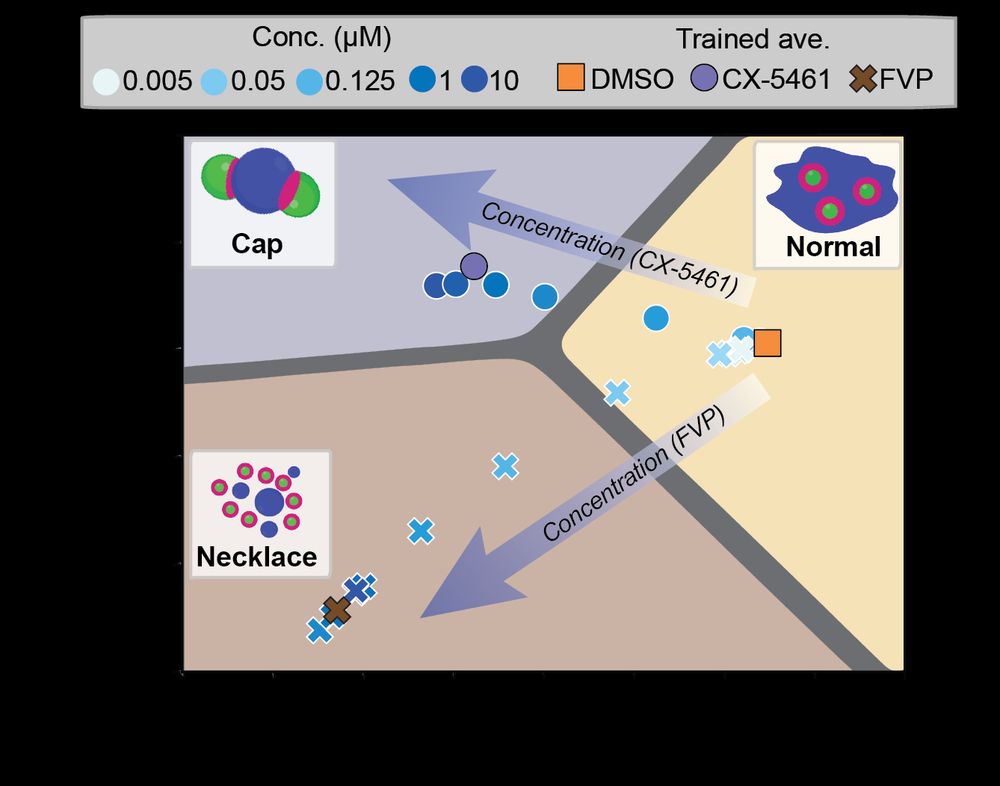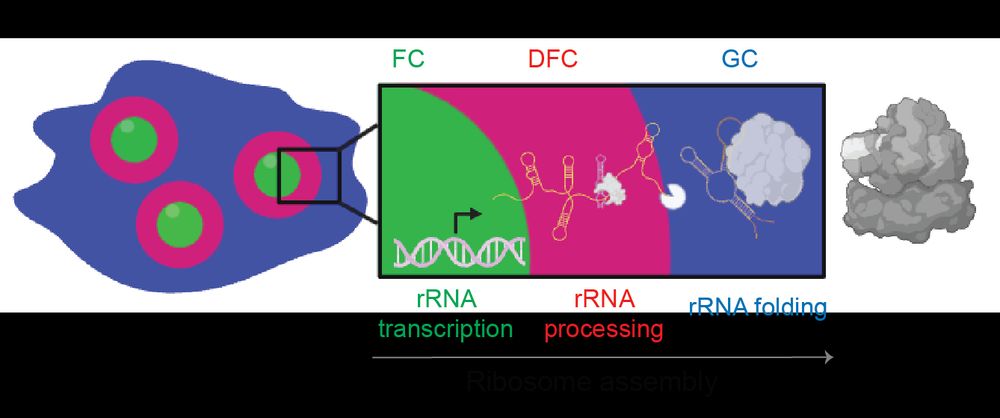Congratulations!! This is so exciting and well-deserved. 🎉
29.09.2025 15:24 — 👍 2 🔁 0 💬 1 📌 0
... Prof. Ai Ing Lim and @kristantunes.bsky.social
for a great help with the virus work, and Cliff @brangwynnelab.bsky.social for all the support and guidance!
20.08.2025 21:16 — 👍 2 🔁 0 💬 0 📌 0
To say that this took a village would be an understatement. I’m incredibly grateful to my collaborators in the @brangwynnelab.bsky.social : Troy Comi, @sofiquinodoz.bsky.social, @nima-jaberi.bsky.social, Lenny Weisner and Lifei Jiang, ...
20.08.2025 21:16 — 👍 1 🔁 0 💬 1 📌 0
🌟 Big picture 🌟
✔️ Condensate morphology encodes function
✔️ Deep-Phase translates images into quantitative readouts of drug biochemical potency
✔️ Future applications: phenotypic screens, MoA studies, biomarkers, single-cell heterogeneity detection (10/10)
20.08.2025 21:16 — 👍 1 🔁 0 💬 1 📌 0

Integrating our discoveries, we came up with a new model for nucleolar phase boundary maintenance, in which both the abundance and processing state of rRNA📊 dictate the multiphase arrangement within this fascinating condensate (9/10).
20.08.2025 21:16 — 👍 2 🔁 0 💬 1 📌 0

These observations led us to hypothesize that sequential cleavage inhibition💊 (invert & push apart DFCs from GC) followed by transcription inhibition💊 (restore DFC-GC interface) could phenocopy the flower 🌸 morphology. This is indeed what we (and Deep-Phase) saw! (8/10)
20.08.2025 21:16 — 👍 1 🔁 0 💬 1 📌 0

We then conduct mechanistic studies 🔎 to find that beyond its recognized role in resolving supercoiling, TOP1 is also involved in rRNA processing! Its inhibition causes rRNA cleavage defects and a drop in transcription of large ribosomal subunit precursors ❌🏭. (7/10)
20.08.2025 21:16 — 👍 2 🔁 0 💬 1 📌 0

To test the utility of Deep-Phase, we conduct a small molecule screen and uncover a unique nucleolar morphology: the "flower" 🌸! This phenotype, where the DFC-GC interface is maintained but inverted, arises specifically upon DNA Topoisomerase I (TOP1) depletion. (6/10)
20.08.2025 21:16 — 👍 1 🔁 0 💬 1 📌 0

Not just nucleoli! We extend Deep-Phase to nuclear splicing speckles✂️ as well as RSV viral cytoplasmic factories🦠, showing that condensate morphology alterations are a quantitative fingerprint of the degree of RNA biochemistry disruptions within them. (5/10)
20.08.2025 21:16 — 👍 1 🔁 0 💬 1 📌 0

In doing so, we measure dose-response curves from images and demonstrate that they match IC50 values from biochemical experiments: nucleolar morphology becomes a quantitative readout of potencies of drugs that alter ribosome biogenesis! 📉➡️📈 (4/10)
20.08.2025 21:16 — 👍 1 🔁 0 💬 1 📌 0

We developed Deep-Phase, an automated imaging and deep neural network-based framework that accurately tracks these changes over treatment times⏲️and concentrations📶 directly from images (no hand-picked features) (3/10).
20.08.2025 21:16 — 👍 1 🔁 0 💬 1 📌 0

Cells organize key processes in biomolecular condensates, such as the multiphase nucleolus where ribosomes are made 🏭. Due to its dynamic and compartmentalized nature, small molecule perturbations of this process💊 lead to fast and distinct morphology rearrangements🌀. (2/10)
20.08.2025 21:16 — 👍 2 🔁 0 💬 1 📌 0
Ai Ing Lim and @kristantunes.bsky.social for a great help with the virus work, and Cliff @brangwynnelab.bsky.social for all the support and guidance!
20.08.2025 20:01 — 👍 1 🔁 0 💬 0 📌 0
To say that this took a village would be an understatement. I’m incredibly grateful to my collaborators in the @brangwynnelab.bsky.social : Troy Comi, @sofiquinodoz.bsky.social, @nima-jaberi.bsky.social , Lenny Wiesner and Lifei Jiang for their hard work and expertise, ...
20.08.2025 20:01 — 👍 0 🔁 0 💬 1 📌 0
🌟 Big picture 🌟
✔️ Condensate morphology encodes function
✔️ Deep-Phase translates images into quantitative readouts of drug biochemical potency
✔️ Future applications: phenotypic screens, MoA studies, biomarkers, single-cell heterogeneity detection
(10/10)
20.08.2025 20:01 — 👍 0 🔁 0 💬 1 📌 0

Integrating our discoveries, we came up with a new model for nucleolar phase boundary maintenance, in which both the abundance and processing state of rRNA📊 dictate the multiphase arrangement within this fascinating condensate. (9/10)
20.08.2025 20:01 — 👍 0 🔁 0 💬 1 📌 0

These observations led us to hypothesize that sequential cleavage inhibition💊 (invert & push apart DFCs from GC) followed by transcription inhibition💊 (restore DFC-GC interface) could phenocopy the flower 🌸 morphology. This is indeed what we (and Deep-Phase) saw! (8/10)
20.08.2025 20:01 — 👍 0 🔁 0 💬 1 📌 0

We then conduct mechanistic studies 🔎 to find that beyond its recognized role in resolving supercoiling, TOP1 is also involved in rRNA processing! Its inhibition causes rRNA cleavage defects and a drop in transcription of large ribosomal subunit precursors ❌🏭. (7/10)
20.08.2025 20:01 — 👍 0 🔁 0 💬 1 📌 0

To test the utility of Deep-Phase, we conduct a small molecule screen to uncover a unique nucleolar morphology: the "flower" 🌸! This phenotype, where the DFC-GC interface is maintained but inverted, arises specifically upon DNA Topoisomerase I (TOP1) depletion. (6/10)
20.08.2025 20:01 — 👍 0 🔁 0 💬 1 📌 0

Not just nucleoli! We extend Deep-Phase to nuclear splicing speckles✂️ as well as RSV viral cytoplasmic factories🦠, showing that condensate morphology alterations are a quantitative fingerprint of the degree of RNA biochemistry disruptions within them. (5/10)
20.08.2025 20:01 — 👍 0 🔁 0 💬 1 📌 0

In doing so, we measure dose-response curves from images and demonstrate that they match IC50 values from biochemical experiments: nucleolar morphology becomes a quantitative readout of potencies of drugs that alter ribosome biogenesis! 📉➡️📈 (4/10)
20.08.2025 20:01 — 👍 0 🔁 0 💬 1 📌 0

We developed Deep-Phase, an automated imaging and deep neural network-based framework that accurately tracks these changes over treatment times⏲️ and concentrations📶 directly from images (no hand-picked features).(3/10)
20.08.2025 20:01 — 👍 0 🔁 0 💬 1 📌 0

Cells organize key processes in biomolecular condensates, such as the multiphase nucleolus where ribosomes are made 🏭. Due to its dynamic and compartmentalized nature, small molecule perturbations of this process💊 lead to fast and distinct morphology rearrangements🌀. (2/10)
20.08.2025 20:01 — 👍 8 🔁 1 💬 1 📌 1
RNA Biologist
Ribosome biogenesis dysfunction diseases
Structure-Function relationships in the Nucleolus
Biomolecular condensates
www.lafontainelab.com
Assistant professor, Rutgers university
Assistant Professor of Physics at WashU working in areas of biophysics and soft matter.
Assistant Professor at Baylor College of Medicine and Texas Children's Hospital. Houston, TX
Science: disorder, condensates, repeats, cell stress, neurodegeneration, drug discovery, synbio Non-science: art, fashion, cooking
www.boeynaemslab.org
signaling systems and protein circuitry. reimagining what cells can be. fun posts only. Assistant Professor:
@uwbiochem | Postdoc: @stanford @prakashlab | Ph.D.:
@ucsf Wendell Lim @CDI_UCSF
Pew Latin American postdoctoral fellow at LIMmunity (Princeton University). A geek. A French horn player. A bird watcher. Um “mistério do planeta” 🇧🇷 🇺🇸 (She/her)
biophysics, cell biology, microscopy | condensates, membranes, RNA | Dept. of Cell & Dev Bio @Northwestern Feinberg
sites.northwestern.edu/sneadlab
Asst. prof at Northwestern ChBE
Interested in how molecules and processes are organized and regulated in living cells | physics, math, engineering, and computation (mostly) for biology
shrinivaslab.com
Scientists using microscopes, math, physics and fun to discover how cells work @Duke Cell Biology/BME. https://gladfelterlab.net
PhD candidate in Brangwynne Lab @ Princeton, previously @ UCLA Chem. and Bio. Eng.
“Science guided by empathy transforms lives.”
LSRF-HHMI Postdoctoral Scientist in the Vosshall lab @Rockefeller University 🦋 PhD in the Brangwynne Lab @Princeton
Assistant Professor at Rutgers Chemistry and Chemical Biology, studies cell membranes and biomolecular condensates.
https://sites.rutgers.edu/shi-lab/
Grad student at MIT Biology | Previously at Princeton
EPIGENETIC HULK SMASH PUNY GENOME. MAKE GENOME GO. LOCATION: NOT CENTROMERE, THAT FOR SURE
Assistant professor @WUSTLmed Biochemistry & Molecular Biophysics. Mitochondria, metabolism, and cell signaling. Mom of 2. Advocate for women in science. www.niemilab.com
Assistant Professor of Molecular Biology, Center for Alzheimer's and Neurodegenerative Diseases, UT Southwestern. My lab studies damaged things. Sometimes we fix them. Hiring! Write if interested in postdoc or tech position. https://www.davidwsanders.com
John V. O'Connor Assistant Prof. in Cancer Drug Discovery @NDScience | Postdoc in @AnnaMapp Lab @UMLifeSciences | Ph.D. @hargrovelab | STAR^2 Lab https://sites.google.com/view/morganlabatnd/
postdoc in Brangwynne Lab @Princeton | formerly MIT Biology, UofT
Professor of Chemistry, University of Toronto
@chemuoft @UTM_CPS
Views expressed are mine alone.
she/her/hers
Phase separation and disordered proteins!
















